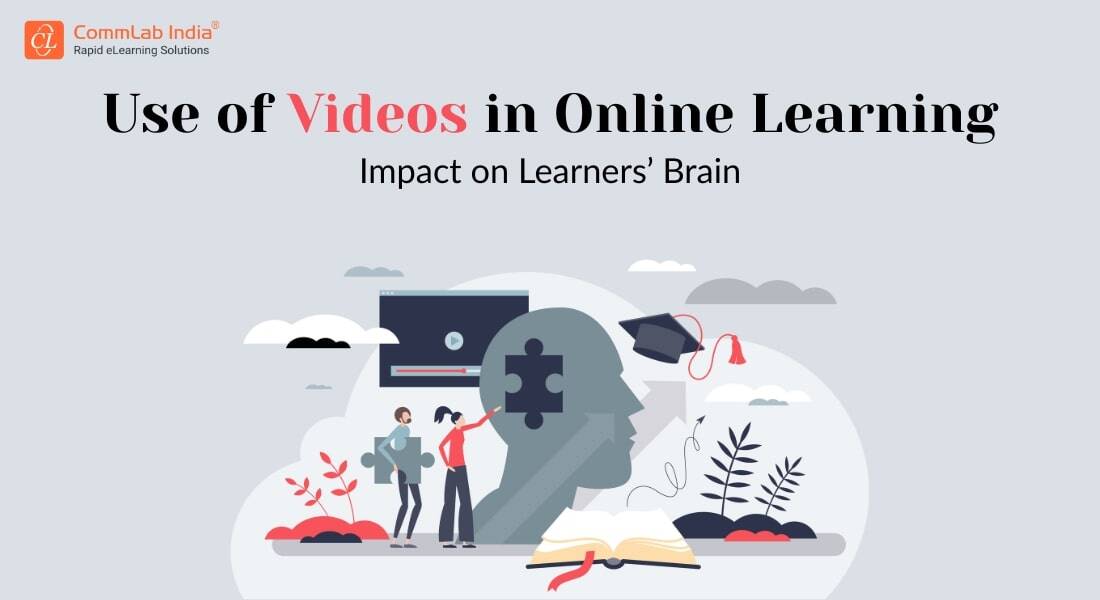Video-based Learning for Effective Training Programs

Generally training managers face many challenges while training their employees based on their training requirements and changing needs. It is mandatory to deliver effective training to employees and update their skills and knowledge. Video-based learning is one of the best ways to deliver training as it improves the effectiveness and efficiency of online learning. If an image is worth a 1000 words, then every video is worth a 10,000 words.
→ Download Now: Are You Ready to Charm Your Learners with the Magic of Videos?
Statistics say that every individual is likely to remember only 10% of textual content, 65% of visual content, but 95% of audio-visual content. Hence, organizations should incorporate this mode of learning to train their employees effectively as it enhances self-learning and engages learners’ attention throughout the course.
In general, people learn better through examples. Video-based learning is the best way to provide visual examples and enhance the learning experience. Hence, for better results, this type of learning must be implemented in the corporate world.
Screens with only text and images can be monotonous to employees. Use video-based learning to provide a welcome break in the monotony of the online course and make it engaging and interesting.
Incorporate videos that will certainly be effective and engaging and more impactful rather than reading reams of text that will put most employees to sleep. Video-based learning adds value to the course and reduces cognitive load on the learners and also helps them retain information for longer periods. In video-based learning, learners connect with the content and thereby complete the course without any distractions.
Let’s see where to use video-based learning.
1. Product Demonstrations
Video-based learning is the best way to show how a product works, how it is to be handled, and demonstrate its features and benefits. It provides a virtual hands-on experience to employees and adds value not only to the sales staff, but also to the customers. Incorporate rich visual animations in video-based learning to grab the employees' attention. It enables employees retain the information for a longer period of time. This video-based learning helps the sales person sell his company's products effectively in the market.

2. Behavioral Skills Training
Video-based learning is a great method for teaching behavioral skills or soft skills and job tasks to be performed at the workplace. These skills will help the employees interact successfully at the workplace.

3. Software Simulations
Video-based learning is used to demonstrate the working of software applications and it helps the organization reduce the operation time and costs by simplifying work processes and minimizing errors at the workplace. It helps employees use the software effectively in real-time and makes them understand the concept or details of the software quickly.

Next-Gen Training: Unlocking the Power of AI in Video-based Learning
Elevate your Training Videos with AI
- Relevance of Video-based Learning
- Various Video Formats
- Potential of AI in Videos
- And More!
4. Induction Training
Video-based learning is a good way to explain the company’s mission and vision to the new employees. Apart from the company’s mission and vision, there are some other training elements that need to be considered an integral part of induction training such as interpersonal skills training, quality training, technology training, legal training, problem-solving training, etc.

5. Course Introduction
Video-based learning is the best way to provide a brief introduction about the course along with the learning objectives. It helps employees know what they are going to learn and what they can expect from the course.
6. Process Training
Video-based learning is the best way to demonstrate the series of steps in a process/procedure or events effectively. It helps employees retain the steps of a process for a longer period of time. Video-based learning helps them understand why and how a process needs to be followed.

Advantages of video-based learning
- Makes the course engaging and effective
- Engages learners effectively throughout the course
- Reduces cognitive load on the learners
- Allows learners retain the concept for a longer period of time
- Enhances the participation and learning experience of learners
Video-based learning is suitable for all kinds of training programs as it increases learning effectiveness and efficiency. It also allows organizations achieve better results faster and quicker.





